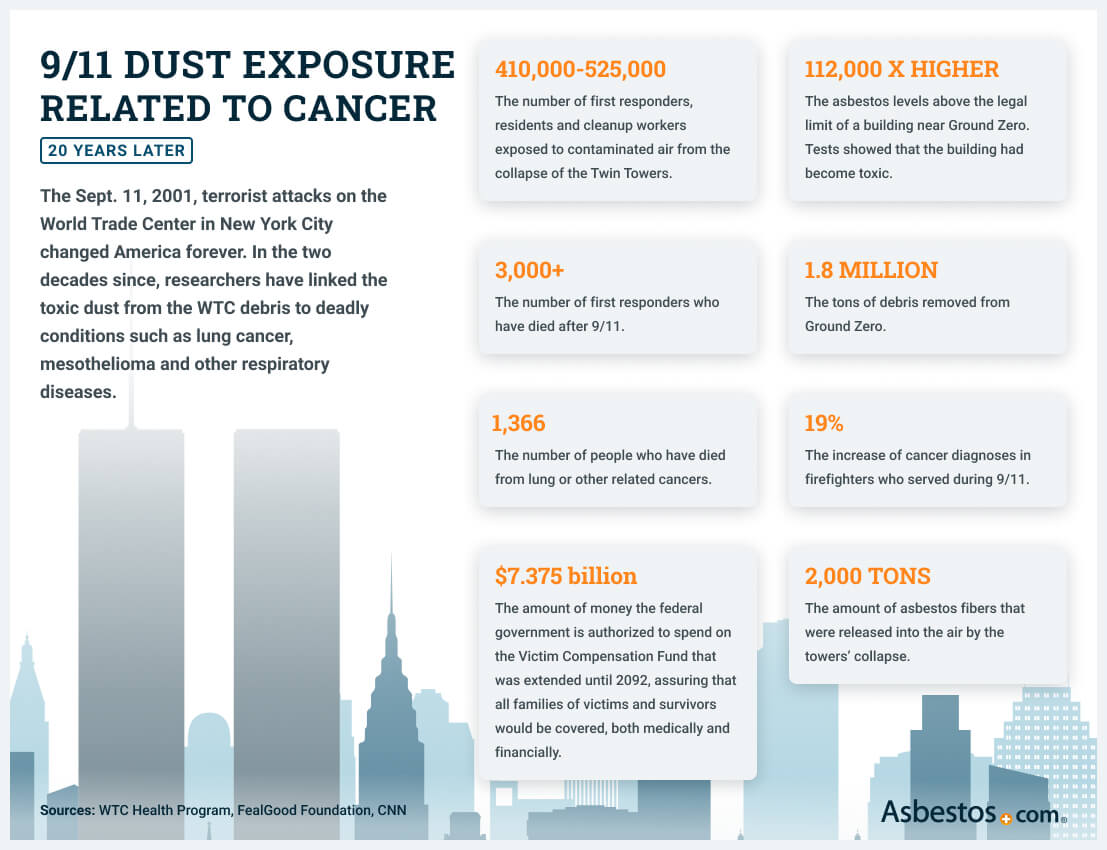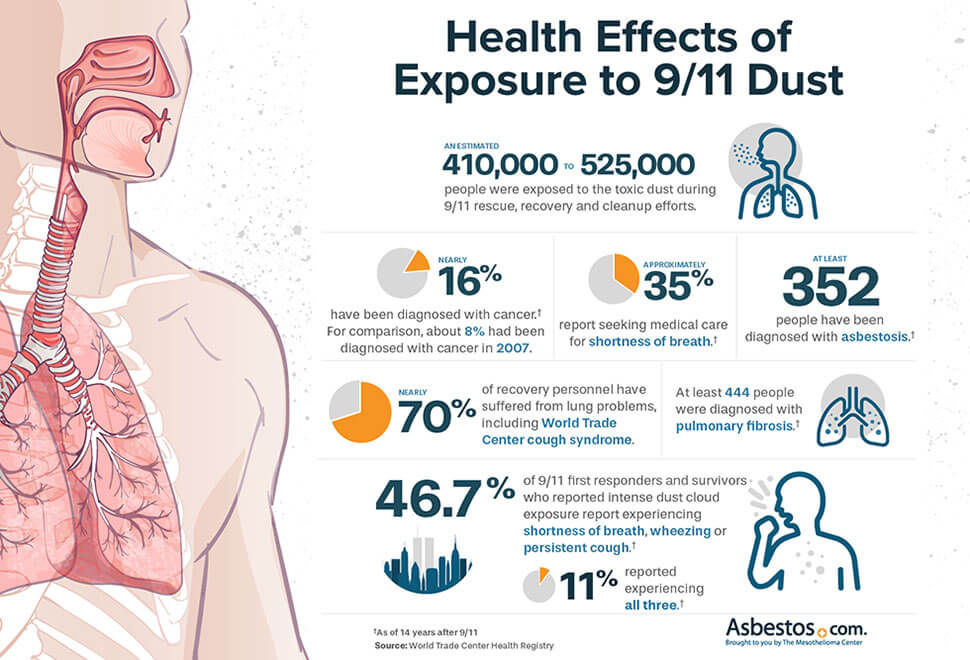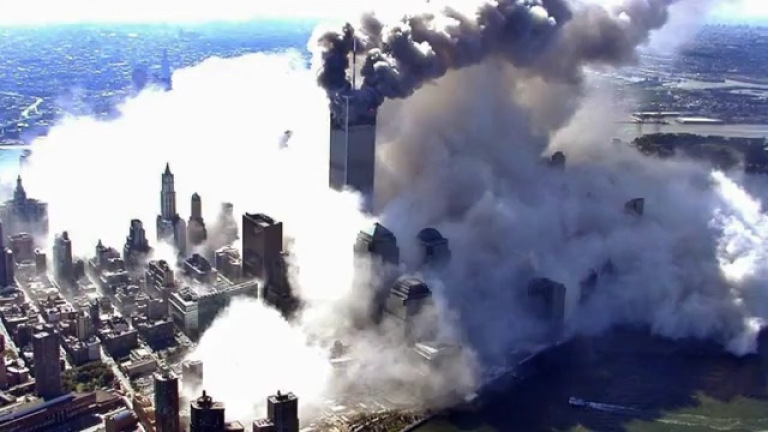Asbestos, 9/11 and the World Trade Center
Toxic asbestos and other carcinogens were released during the Sept. 11 attacks on the World Trade Center. First responders, survivors and residents exposed to the dust are developing health effects such as respiratory diseases and cancer.
Asbestos Exposure and 9/11
The collapse of the twin towers on Sept. 11, 2001, released a toxic plume across lower Manhattan. It contained 400 tons of pulverized asbestos and other hazardous materials.
World Trade Center Dust Composition
- 50% nonfibrous construction materials
- 40% glass and other fibers
- 9.2% cellulose from disintegrated paper
- 0.8% asbestos
An estimated 410,000 to 525,000 people were exposed to the toxic dust. This included more than 90,000 workers involved in the rescue, recovery and cleanup efforts.

Who Is at Risk of Health Effects?
According to the World Trade Center Health Program, anyone within a 1.5-mile radius of the center was at risk of exposure to asbestos. Other carcinogens included lead, mercury, benzene and dioxins.
People Most at Risk
- First responders, including firefighters
- Search and rescue workers
- Cleanup workers
- Survivors and residents
A 2011 study of firefighters exposed to this dust proved the group is 19% more likely to develop cancer than the general population.
Why Was Asbestos in the World Trade Center?
During the construction of the World Trade Center in the late 1960s and early 1970s, developers commonly used asbestos in construction materials to make them stronger and heat resistant.
A variety of asbestos-containing products were incorporated into both towers.
For example, spray-on asbestos fireproofing material was applied to steel beams along the first 40 floors of the north tower. Amid construction, the builders discontinued using asbestos because stricter regulations on the mineral were expected soon.
Health Effects from Exposure to 9/11 Dust
The World Trade Center Health Registry tracks the health effects from exposure to 9/11 dust. According to the registry, those health effects include respiratory diseases, gastrointestinal conditions, cancer and psychological conditions.
2016 Health Survey Facts
- At least 352 people have been diagnosed with asbestosis.
- In addition, at least 444 people were diagnosed with pulmonary fibrosis. Exposure to asbestos and other fibers in 9/11 dust may have contributed to these cases.
- Nearly 16% have been diagnosed with cancer. For comparison, about 8% had been diagnosed with cancer in 2007.
- Approximately 35% report seeking medical care for shortness of breath.
- Nearly 70% of recovery personnel have suffered from lung problems, including World Trade Center cough syndrome.
The most common respiratory health effect is known as “World Trade Center cough syndrome.” It involves chronic rhinosinusitis, asthma and bronchitis. All of these are complicated by gastrointestinal reflux disease.

9/11-Related Cancers and Conditions
According to the World Trade Center Health Registry, the 10 most common cancers include:
- Prostate cancer
- Breast cancer
- Thyroid cancer
- Lung cancer
- Kidney cancer
- Colon cancer
- Nonmelanoma skin cancer
- Melanoma
- Lymphoma
- Leukemia
As of 2021, nearly 24,000 people had been diagnosed with 9/11-related cancer.
Other health effects registry reports include chronic obstructive pulmonary disease, sleep apnea, musculoskeletal syndromes, sarcoidosis (an inflammatory disease), post-traumatic stress disorder, anxiety and depression.
In all, more than 63,000 people have been diagnosed with a 9/11-related health condition.
Mesothelioma and 9/11 Dust
While the survey hasn’t reported on cases of mesothelioma yet, it has reported on three presenting symptoms of mesothelioma: Shortness of breath, wheezing and persistent cough.
Of the more than 9,000 people who endured heavy exposure to 9/11 dust, nearly half (46.7%) reported one or more of these symptoms and 11% reported all three.
According to mesothelioma expert Dr. Raja Flores of New York’s Mount Sinai Hospital, the number of mesothelioma cases related to 9/11 dust have been minimal, but they are expected to increase soon.
“We haven’t seen many yet, but we’re going to see a very significant rise in [mesothelioma] cases,” Flores said. “What I am seeing is a lot more esophageal cancers. Would they have developed anyway? Or are they a result of all the exposure? I think exposure. The patients seem a lot younger now. It’s going to be another 30 to 40 years before all this plays out.”
In 2020, 9/11 first responder and firefighter Nick Ursta died of pleural mesothelioma. Ursta and his wife spent three days at Ground Zero while sharing a mask to protect themselves from the dust. The oncology team at the University of Pittsburgh Medical Center who treated Ursta believed his exposure to 9/11 dust caused his cancer.
Only one other case of mesothelioma has been reported. In 2006, first responder and paramedic Deborah Reeve died of mesothelioma at the age of 41. She developed a serious cough not long after the attacks and was diagnosed with mesothelioma in 2003. Her doctors believed her exposure to asbestos at Ground Zero led to her cancer.
Health Safety Tips Following Exposure to 9/11 Dust
Anyone exposed to 9/11 dust should closely monitor their health. Catching symptoms early can lead to better mesothelioma treatment options and improved survival outcomes. Doctors from the World Trade Center Health Program have recommended health tips to those exposed to 9/11 dust.
Health Tips for 9/11 Dust Exposure
- Get a complete medical evaluation of your respiratory system and digestive system.
- Get a comprehensive mental health evaluation.
- Follow through with the treatments and medications prescribed by your doctor.
- Seek multidisciplinary treatment that addresses your physical and mental health.
- Manage chronic conditions well, which can control their severity over time.
Responders and survivors are eligible to receive annual monitoring exams, benefits counseling services, and medical and mental health care for covered 9/11 conditions through the World Trade Center Health Program.
Additionally, veterans who were deployed to Ground Zero as responders may be eligible for VA health care benefits.
Compensation for Responders and Survivors
Following the 10th anniversary of the 9/11 attacks, the U.S. government passed the James Zadroga 9/11 Health and Compensation Act, a law created to provide medical care and monitoring to people with health conditions related to 9/11.
The law builds upon the 2001 September 11th Victim Compensation Fund. Its approval, which set aside $8.1 billion in funds, extended the benefits to first responders, cleanup workers, New York City residents and others who were exposed to 9/11 dust.
Thanks to the Zadroga Act, and subsequent efforts to extend it over the years, more than 19,000 responders and survivors have received compensation from the September 11th Victim Compensation Fund.
Fighting for Proper Funding
The original terms of the Zadroga Act only offered compensation from 2011 to 2016, Congress voted to reauthorize the program in 2015.
The renewal was intended to secure lifetime health care for qualified claimants, who may develop asbestos-related illnesses, such as mesothelioma, decades after their exposure to 9/11 dust. However, in February 2019, the fund’s administrator announced there wasn’t enough in the fund to pay all pending and projected claims.
Pending claims were cut by 50% and new claims by 70%.
On June 11, 2019, the former host of “The Daily Show,” Jon Stewart, testified before the House Judiciary Committee to demand additional funding. The next day the committee passed a bill to permanently reauthorize the September 11th Victim Compensation Fund and extend it until 2092.
9/11 Lawsuits and Settlements
Tens of thousands of people exposed to 9/11 dust have developed serious respiratory conditions and several types of cancer. Many have filed lawsuits to seek compensation for asbestos exposure, alleging the dust caused their health problems.
9/11 Legal Settlements
- In 2010, more than 10,000 rescue and recovery workers claiming dust-related injuries opted into a $713 million court settlement from WTC Captive Insurance Co. Inc.
- Previous settlements with other defendants, including the Port Authority of New York and New Jersey, bring the total settlement awards to about $810 million.
A study published in Molecular Cancer Research earlier this year discovered that 9/11 victims with prostate cancer had a unique increase in a certain T-cell that isn’t seen in other prostate cancer patients. Researchers concluded that 9/11 dust could cause an inflammatory response in the prostate that increases the risk of cancer.
Before 2012, the Zadroga Act did not offer compensation to claimants who developed cancer because of the lack of evidence linking cancer to 9/11 dust. People with cancer now can file a claim, but payments will be reduced if the claimant is awarded money from a 9/11 lawsuit.
Because asbestos-related cancers are slow to develop, lawsuits linking these conditions to 9/11 dust may arise in the near future.
Dr. Craig Stevens, a mesothelioma specialist at the Beaumont Cancer Institute in Michigan, predicts that asbestos-related diseases stemming from 9/11 will peak by 2041.
“It’s difficult to know the absolute risk for each person, but I would expect a rash of mesothelioma and lung cancer cases to begin 20 years after 9/11 and to peak about 40 years after 9/11,” Stevens said. “It is a looming health problem that is underestimated right now by the general public.”
Recommended Reading


